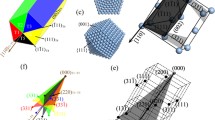Abstract
In most cases, despite the bandgap tuning flexibility of ternary semiconducting nanowires, phase mixing during nanowire growth is inevitable because of the surface energy competition between the bulk stable zinc blende (ZB) and the metastable wurtzite (WZ) phase. As the electronic structure of the grown nanowires depends on not only the composition but also the crystal structure of the nanowires, careful characterization of the phase mixing phenomena in the nanowires is significant. However, because most of the phase analysis of grown nanowires relies on transmission electron microscopy (TEM), the phase analysis should be local, requires destructive sample preparation, and has a high time cost. Here, we developed a modified reciprocal space mapping method exploiting laboratory-based high-resolution X-ray diffraction (HR-XRD) for phase analysis in a one-dimensionally grown nanowire array on a (111) Si substrate in one measurement sequence. The main difficulty of phase analysis in a nanowire array using HR-XRD is the overlap of the diffraction peaks resulting from the structural similarity between ZB and WZ. Using the proposed method, we could successfully separate the diffraction overlapping of the WZ and ZB phases and reveal the lattice constants, composition, and effect of the strain of an InAsxP1−x nanowire array corresponding to the growth conditions in one measurement sequence. We also found that the crystallinity of metastable WZ was considerably lower than that of the bulk stable ZB in InAsxP1−x and that a phase fraction of WZ and ZB in InAsxP1−x nanowire arrays could be tuned by adjusting their composition and diameter.
Graphic Abstract





Similar content being viewed by others
References
Dasgupta, N.P., Sun, J., Liu, C., Brittman, S., Andrews, S.C., Lim, J., Gao, H., Yan, R., Yang, P.: 25th Anniversary article: semiconductor nanowires—synthesis, characterization, and applications. Adv. Mater. 26, 2137–2184 (2014). https://doi.org/10.1002/adma.201305929
Royo, M., De Luca, M., Rurali, R., Zardo, I.: A review on III-V core-multishell nanowires: growth, properties, and applications. J. Phys. D. Appl. Phys. 50, 143001 (2017). https://doi.org/10.1088/1361-6463/aa5d8e
Ning, C.Z., Dou, L., Yang, P.: Bandgap engineering in semiconductor alloy nanomaterials with widely tunable compositions. Nat. Rev. Mater. 2, 1–14 (2017). https://doi.org/10.1038/natrevmats.2017.70
Zhang, Y., Wu, J., Aagesen, M., Liu, H.: III-V nanowires and nanowire optoelectronic devices. J. Phys. D. Appl. Phys. 48, 463001 (2015). https://doi.org/10.1088/0022-3727/48/46/463001
Fang, M., Han, N., Wang, F., Yang, Z.X., Yip, S., Dong, G., Hou, J.J., Chueh, Y., Ho, J.C.: III-V nanowires: synthesis, property manipulations, and device applications. J. Nanomater. 2014, 702859 (2014). https://doi.org/10.1155/2014/702859
Barrigón, E., Heurlin, M., Bi, Z., Monemar, B., Samuelson, L.: Synthesis and applications of III-V nanowires. Chem. Rev. 119, 9170–9220 (2019). https://doi.org/10.1021/acs.chemrev.9b00075
Choi, S.B., Oh, M.S., Han, C.J., Kang, J.-W., Lee, C.-R.: Conformable, thin, and dry electrode for electrocardiography using composite of silver nanowires and polyvinyl butyral. Electron. Mater. Lett. 15, 267–277 (2019). https://doi.org/10.1007/s13391-019-00125-y
Ma, S., Feng, S., Kang, S., Wang, F., Fu, X., Lu, W.: A high performance solar-blind detector based on mixed–phase Zn0.45Mg0.55O alloy nanowires network. Electron. Mater. Lett. 15, 303–313 (2019). https://doi.org/10.1007/s13391-019-00121-2
Kaur, N., Zappa, D. & Comini, E. Shelf life study of NiO nanowire sensors for NO2 detection. Electron. Mater. Lett. 15(6), 743–749 (2019). https://doi.org/10.1007/s13391-019-00172-5
Wang, C., Wu, H., Zhu, H. et al.: Effects of sulfur doping on generalized stacking fault energy of indium phosphide. Electron. Mater. Lett. 16, 506–511 (2020)
Jung, C.S., Kim, H.S., Jung, G.B., Gong, K.J., Cho, Y.J., Jang, S.Y., Kim, C.H., Lee, C.W., Park, J.: Composition and phase tuned InGaAs alloy nanowires. J. Phys. Chem. C 115, 7843–7850 (2011). https://doi.org/10.1021/jp2003276
Shin, J.C., Kim, K.H., Yu, K.J., Hu, H., Yin, L., Ning, C.Z., Rogers, J.A., Zuo, J.M., Li, X.: InxGa1-xAs nanowires on silicon: one-dimensional heterogeneous epitaxy, bandgap engineering, and photovoltaics. Nano Lett. 11, 4831–4838 (2011). https://doi.org/10.1021/nl202676b
Shin, J.C., Lee, A., Mohseni, P.K., Kim, D.Y., Yu, L., Kim, J.H., Kim, H.J., Choi, W.J., Wasserman, D., Choi, K.J., Li, X.: Wafer-scale production of uniform InAsyP1-y nanowire array on silicon for heterogeneous integration. ACS Nano 7, 5463–5471 (2013). https://doi.org/10.1021/nn4014774
Akiyama, T., Sano, K., Nakamura, K., Ito, T.: An empirical potential approach to wurtzite-zinc-blende polytypism in group III–V semiconductor nanowires. Jpn. J. Appl. Phys. Part 2 Lett. 45, L275 (2006). https://doi.org/10.1143/JJAP.45.L275
Lee, J.H., Pin, M.W., Choi, S.J., Jo, M.H., Shin, J.C., Hong, S.G., Lee, S.M., Cho, B., Ahn, S.J., Song, N.W., Yi, S.H., Kim, Y.H.: Electromechanical properties and spontaneous response of the current in InAsP nanowires. Nano Lett. 16, 6738–6745 (2016). https://doi.org/10.1021/acs.nanolett.6b02155
Kim, I., Kim, H.S., Ryu, H.: Piezoresistivity of InAsP nanowires: role of crystal phases and phosphorus atoms in strain-induced channel conductances. Molecules 24, 3249 (2019). https://doi.org/10.3390/molecules24183249
Ertekin, E., Greaney, P.A., Chrzan, D.C., Sands, T.D.: Equilibrium limits of coherency in strained nanowire heterostructures. J. Appl. Phys. 97, 114325 (2005). https://doi.org/10.1063/1.1903106
Chuang, L.C., Moewe, M., Chase, C., Kobayashi, N.P., Chang-Hasnain, C., Crankshaw, S.: Critical diameter for III–V nanowires grown on lattice-mismatched substrates. Appl. Phys. Lett. 90, 043115 (2007). https://doi.org/10.1063/1.2436655
Park, Y., Cich, M.J., Zhao, R., Specht, P., Weber, E.R., Stach, E., Nozaki, S.: Analysis of twin defects in GaAs(111)B molecular beam epitaxy growth. J. Vac. Sci. Technol. B Microelectron. Nanom. Struct. 18, 1566 (2000). https://doi.org/10.1116/1.591427
Niewczas, M.: Lattice correspondence during twinning in hexagonal close-packed crystals. Acta Mater. 58, 5848–5857 (2010). https://doi.org/10.1016/j.actamat.2010.06.059
Cullity, B.D., Stock, S.R.: Elements of X-Ray Diffraction. Pearson, London (2001)
Acknowledgements
This research was supported by Establishment of the Foundation for Advanced Materials Measurement Platform funded by the Korea Research Institute of Standards and Science (KRISS-2021-GP2021-0011) and the National R&D Program through the National Research Foundation of Korea (NRF) funded by the Ministry of Science and ICT (Grant No. 2020R1C1C1014257).
Author information
Authors and Affiliations
Corresponding authors
Additional information
Publisher's Note
Springer Nature remains neutral with regard to jurisdictional claims in published maps and institutional affiliations.
Rights and permissions
About this article
Cite this article
Jeong, IY., Choi, M., Kim, J. et al. Mixed Phase Confirmation of InAsxP1−x Nanowire Array Using Modified Reciprocal Space Mapping. Electron. Mater. Lett. 18, 79–86 (2022). https://doi.org/10.1007/s13391-021-00315-7
Received:
Accepted:
Published:
Issue Date:
DOI: https://doi.org/10.1007/s13391-021-00315-7




